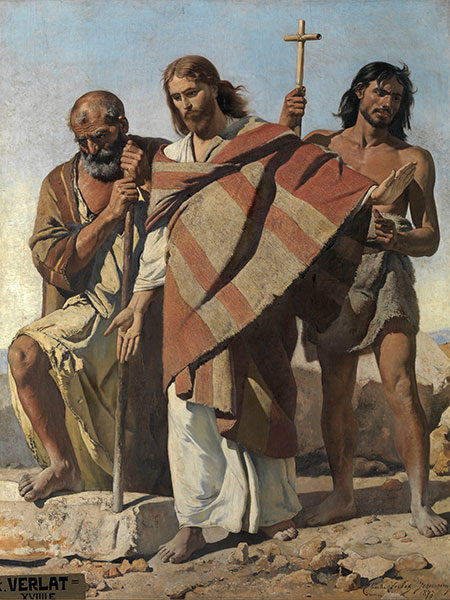Simon Peter’s Special Visit

A father's doting influence on his young son. (Unsplash/Daiga Ellaby)
“But what about Peter?” asked my son DeForeest as we drove home from Easter Vigil Mass many years ago.
I’d started telling him about Jesus from the time he began to talk. By the age of three, DeForeest was familiar with much of the Gospel and showed interest in its supporting cast. I aided his imagination with occasional vocal characterizations for the various Apostles, Pharisees, centurions, and townsfolk wandering in and out of Scripture.
Preparing DeForeest for Holy Week, we went over the events of the Passion, including background on Peter, John, Thomas, Lazarus, and his sisters, Martha and Mary of Bethany. As a prelude to Easter, I told him how Jesus had rescued Lazarus from death — making sure to refer to Martha’s down-to-earth comment that, after four days in the grave, her brother’s body “must surely stinketh” as the older translations put it. As hoped, I was rewarded with a gale of laughter.
Continuing through the Last Supper and trial, we came to Peter’s denials. DeForeest had known Simon Peter as a rollicking, friendly, and loyal companion. But, hearing of Peter’s three denials as he warmed himself by the charcoal fire in the high priest’s courtyard on that chill spring night, my son’s face showed dismay, followed by shock when he learned that Peter’s final denial, says St. Mark, came with "cursing and swearing." Mark took his Gospel from Peter's own preaching, we’re told, so it’s likely that this pungent detail came from the tough-talking Apostle himself.
I told DeForeest how St. Luke, the gentlemanly historian, omitted Peter's rough language but added a wrenchingly poignant incident. Simon Peter's final denial came with Jesus, under guard, being duck-walked across the courtyard. Luke reveals that it wasn't the crowing of the rooster that reminded Peter of Jesus' prophecy at dinner. It was when "the Lord turned and looked straight at Peter, and Peter remembered" (Luke 22:61). Only then did the words, "Before cockcrow, you will deny knowing Me three times" flood into Peter’s memory.
Jesus’ glance was no mournful, pitying gaze as paintings and films often depict the moment. The Greek word for the description of the glance means “to observe intently.” Hearing Simon Peter’s repudiation, Jesus reacted in a very human way. Paraded past the Galilean fisherman, the Lord deliberately turned round to shoot a sharp glare at His friend so that, looking into the eyes of Jesus, Peter saw the reflection of a great, blustering coward.
Overcome with shame, he fled, shedding hot, acrid tears. For the rest of his life, Simon Peter would carry the odious recollection that he denied knowing Jesus to His face.
I told DeForeest the rest of the story, how Jesus was cruelly executed but, being crucified, reconciled all people to God and then, after three days, majestically conquered death as a pledge that we, too, will rise in glorified bodies.
The boy nodded impatiently. “But what about Peter?” he demanded.

I thought a moment and remembered how Jesus’ uncle Cleophas and a friend were walking to the village of Emmaus that first Easter morning. They met Jesus on the road, but He was in disguise. After the Lord revealed Himself, they dashed back to Jerusalem with the news.
“The Lord is risen!” they cried, only to hear the Apostles reply, “The Lord is risen, indeed, and hath appeared to Simon.” I explained to DeForeest that “Simon” was Simon Peter. Jesus paid him a special visit before appearing to the others, but we don’t know what took place.
“Well, I know,” DeForeest said matter-of-factly. “Jesus visited Peter to let him know that He forgave him for being afraid. Jesus would do that because Peter was His friend.”
From the uncomplicated mind of a child came a deduction worthy of Sherlock Holmes.
I told DeForeest that the greeting, “The Lord is risen!” with its Gospel countersign, “The Lord is risen, indeed!” is used in many parts of the world as a greeting during Eastertide.
“Why don’t they add ‘and hath appeared to Simon’?” DeForeest asked suspiciously. “It’s important to remember that Jesus forgave Simon Peter for not being a friend,” he decided with impeccable three-year-old logic. The explanation that the addition would complicate the greeting’s meaning satisfied DeForeest not at all. He was adamant: “And hath appeared to Simon” had be part of the reply since it is in the Gospel.
Thirty-one years since, although it is now by phone, each Easter Sunday morning, I waken my son with, “The Lord is risen!” Even when he was still a tyke, and I stood over his bed, DeForeest, his eyes often still shut, would always give me a sleepy smile with the happy reply, “The Lord is risen, indeed, and hath appeared to Simon!”
Thus a beloved family tradition was born.
Thus began an appreciation of the Easter message of forgiveness.
A note to all Catholic parents everywhere — children are never too young to learn about Jesus, their devoted Friend who loves them so much. It’s never too soon to start faith-filled traditions with them.
So go, thou, and do likewise.
Sean M. Wright, award-winning journalist and Emmy-nominated television writer, is a Master Catechist for the Archdiocese of Los Angeles and member of Our Lady of Perpetual Help parish in Santa Clarita, He replies to comments sent him at [email protected].
